Genre: FPS Developer: Domark Publisher: Domark Players: 1-2 Released: 1994
I found Bloodshot via an Internet search of “Genesis FPS” in the vain hope of finding such a game for my recently dusted off Genesis, fresh out of the parents’ attic. I’d just become fed up with my PlayStation 2 and roaming around San Andreas, not really doing anything. The only really good thing about that was the shooting, so I got to thinking, “did anything like this ever come out for the Genny?” I was surprised to find that yes, two or three FPSs did, some were better than others, and one seemed best of the bunch…
As an Elite Trooper of the Earth Federation Starfleet Command (Who else?), your brain has been implanted with the “Battle Frenzy” chip, which gives you “super strength, lightning reflexes, and an insatiable desire to kill.” The briefing in the instruction manual goes on to describe this condition as “Bloodshot.” Your mission, as with many games of this type, is to indiscriminately waste legions of alien robots on an alien spaceship. Always a laugh.
The title screen shows the face of one of these robots, a hideous monstrosity drawn beautifully, with a very clearly sampled robotic “Welcome” heard. There is a nice opening sequence of quick cuts giving the background to the game’s story and a textual outline of your mission. Press start and you’re sent to the options screen where you can configure your game. There aren’t many options, but what is there is fairly useful. There is a welcome, if not amazing two-player mode also, but more on that later.
On starting the game proper, you hear again the robotic welcome from the title screen, open the door and you’re in the ship. As well as all the killing of robots (and there is a lot of that) you have to make your way through the level using the HUD map to the stage’s Plasma Node, which you have to destroy in order to progress. Once the node is destroyed you have to make your way back to the start of the level before the sixty-second timer expires, if you don’t, the node explodes, and you go with it. Bummer.
You can “save” your place by shooting way markers, at which you will respawn in the event of your death. You appear at the last one you destroyed. Leaving one near to the start of the level is a good idea, if you don’t think you’ll make it back from the plasma node in time you can shoot ahead and respawn there ready to run through the door to the next stage. The HUD map is a useful tool, too. It takes up little room on the screen but is placed nicely and does its job well. As good as the gameplay is, considering all the limitations, it can be a bit monotonous though. With that in mind, I would have liked a battery save or level code system, as the game is quite long with twelve levels.
The controls are, for the most part, smooth and responsive. You might occasionally get that glued-to-the-spot syndrome when near a wall or other obstacle, but it’s rare, making it easy to shoot robots or run back to the safe point. You only use three buttons, which is good in the simplistic sense, but I would have liked the other three to be used for weapon selection etc., rather than cycling through with button C.
The graphics are very good. Definitely above par for the Genesis, the 3D scrolling is smooth, and very Wolfenstein-like, rarely getting choppy unless there are a few sprites on screen at once. Even then though, proceedings are still remarkably smooth, and don’t retract from the enjoyment of playing. The action is almost full-screen – at least three quarters is devoted to the gaming window – with the rest of the space nicely utilized for the usual info. It looks and plays beautifully on the Nomad, the first-person aspect cutting down on any blurring. Two-player vertical split screen suffers a bit more however, but with a big enough TV and a little time to get used to this it plays well enough to have an hour’s battling or so, increasing the replay value. Four players would have been ideal, but of course out of the question with this hardware.
Enemy robots are quite detailed and varied. Some are hideous cyborg-like floating monstrosities, that look like cool ’80s animatronic latex horrors. Others are like Terminator-style endoskeletons. They scale well and are as nicely animated as I imagine would be possible due to technical limitations. That does seem to be a feature of this game throughout, the real “packing in” of as much as one could to make this game as good as it could be.
The weapons are of the usual rapid fire, rocket launcher varieties, but with some quite unique guns too: the piercer is a useful addition to your arsenal for example. I did miss seeing the gun held in front of the player though, which is absent in this game. The projectiles scale nicely into the distance, causing quite satisfying explosions, and leaving nice little piles of metallic robot guts all over the place, which don’t fade away. This leaves you a trail of breadcrumbs littered about the stages, which help stop you from getting lost, and reminding you what an insatiable desire to kill you’ve got.
The explosions don’t sound too exciting, but there is a nice variety of clearly sampled robot death screams and battle roars, and grunts when you take hits. Definitely above par for the Genesis, and of a similar quality to samples found on games like Comix Zone for example. Gun sounds get the job done quite nicely, if a bit generically. There is music on the title and intro screens, which gets the adrenaline going nicely with a foreboding build to a fast tempo techno number looped repetitively. No in-game music though, and again likely due to limitations of the time. What we get are background sound effects of the ship’s computer and controls etc, mainly bleeps with an underlying continuous base rumble. While not outstanding in any way, it does evoke a sense of immersion in the environment, and along with the dark graphics creates an eerie feel, which is perhaps better than having in game music at all.
There were precious few FPS games released for the Genesis, which is a shame, as the black box was well known (rightly or wrongly) for its prowess with shooters and most systems of today can boast some sort of flagship FPS. Maybe the Gen wasn’t best suited to this type of genre, but I think it’s fair to say that Bloodshot disproves that. I would have scored it an eight, maybe higher if there was a level code system, but it’s well worth a play (it’s quite common and reasonably priced on auction sites) and does give us at least one good, solid experience of this type on our aging consoles.
SCORE: 7 out of 10


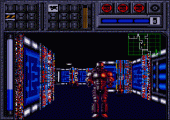
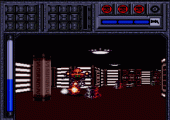
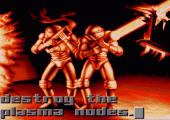
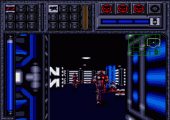
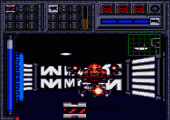
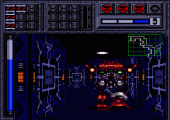
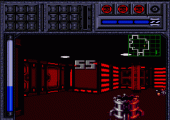
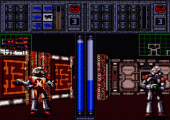
Can’t say I agree with this review. The levels all pretty much look the same, there’s a lack in overall variety, and movement’s too jerky for my tastes. The two-player splitscreen mode was a nice touch, though – this is pretty much the only 2-player-vs shooter on the Genesis.